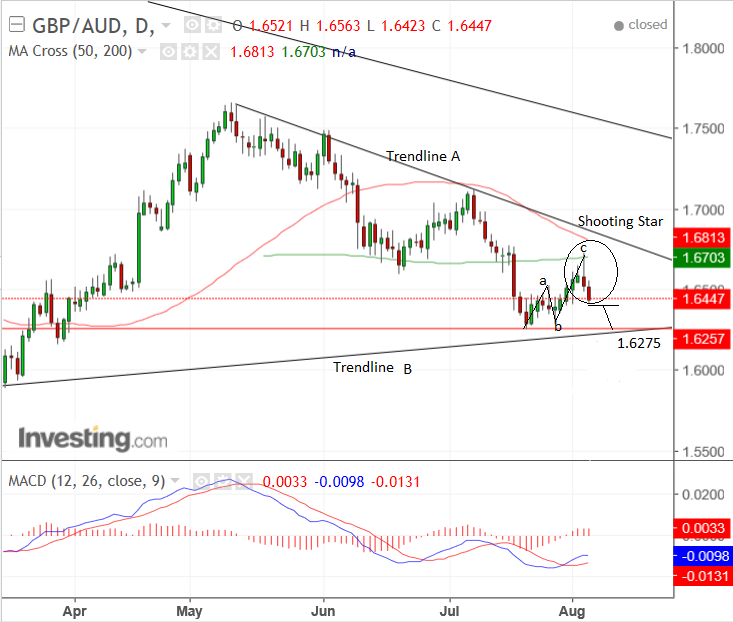GBP/AUD: Forecast for the Next Five Days

The downtrend in the Pound to Australian Dollar looks at risk of resuming as the new trading week begins.
The pair pulled back in a classic three-wave correction during the second half of July before moving lower again ovr the last few days - it now looks set to continue down.
Bank analysts are generally also bullish the Aussie Dollar, seeing more upside in the short-term, with “momentum difficult to ignore,” according to Morgan Stanley, which fits with the gathering evidence of a technical extension lower in GBP/AUD.
“We expect the AUD to continue to move higher in the short-term as yield-seeking behavior continues,” says Morgan Stanley’s Hans Redeker in a recent note, which highlights how the Aussie still gains inflows from investors seeking a higher return on their money, since base interest rates in Australia are higher than most of the G10 at 1.5%.
“AUD has traded well recently even despite more dovish soundings from the RBA and weak CPI data, which to us signals that broader macro drivers are propelling the currency, rather than domestic policy expectations,” adds Redeker.
Given Thursday’s bearish shooting star chart pattern and the confirmation provided by the down-day on Friday, the evidence is suggesting the Aussie will strengthen against the pound in the immediate future, and a move below 1.6420 would confirm such an extension, to a target at the level of Trendline (B) at 1.6275.

Is the fall in value of Sterling impacting your international payments? Get up to 5% more foreign exchange by using a specialist provider by getting closer to the real market rate and avoid the gaping spreads charged by your bank for international payments. Learn more here.
Data for the Australian Dollar
The first main data event for the Australian Dollar is NAB Business Confidence in July, which if expected out on Tuesday, August 8, at 02.30 BST.
The next release is Westpac Consumer sentiment on Wednesday, August 9, at 01.30 GMT and then Home Loans, which are forecast to rise 1.6% in June, (compared to the previous month).
Data for the Pound
A rather thin week for UK data kicks off on Monday morning with Halifax House prices at 8.30 BST and the consensus estimate arguing for a 2.0% rise year-on-year and a 0.2% rise month-on-month.
Given House Prices fell a hefty -1.0% in June, analysts will be checking whether that was just a blip on the cardiogram rather than a deeper decline as a consequence of the economic slowdown.
Then at 00.01 on Tuesday, the BST, British Retail Consortium’s Retail Sales monitor will be released.
This is a sentiment survey asking people in the Retail sector how things are going.
Analysts may being paying more attention to it given the rising rate of inflation and the squeeze in real earnings this has created.
On Thursday, August 10, the RICS House Price balance is to be released, with a probable 8.0% rise expected.
The most important event for Sterling this week comes at 9.30 on Thursday we have Industrial and Manufacturing Production for June.
Previous monthly readings have confirmed the sector to be in contraction, and it appears market expectations aren't any more constructive for when it comes to the June data.
Manufacturing production is forecast to read at 0%, up from the previous month's -0.2%.
Industrial production is forecast to read at 0.1%, an improvement on the previous month's -0.1%.
With expectations regarding Sterling and the UK economy in a downbeat mode, positive surprises on the data front could provide some welcome upside for the currency.
The Trade balance for June is out at the same time, and is expected to show the deficit narrowing to 11.00bn from 11.86bn previously.




